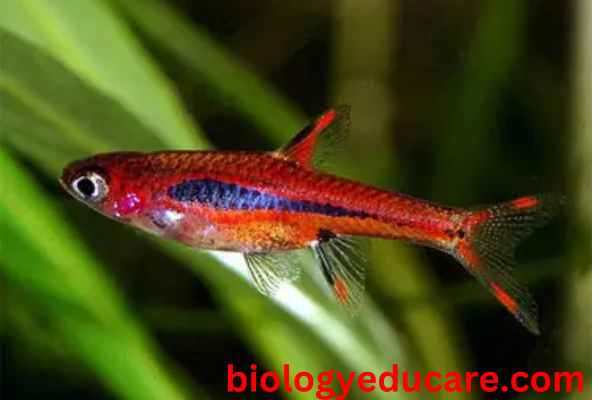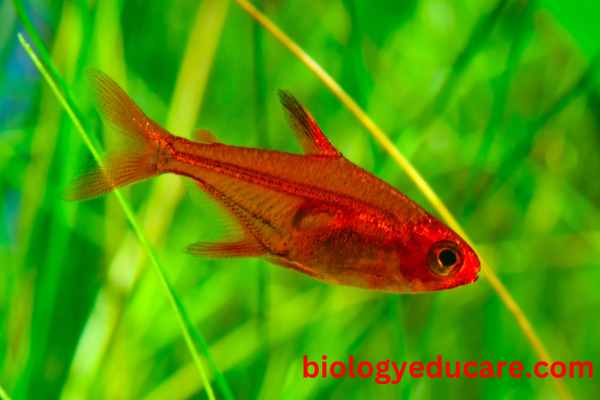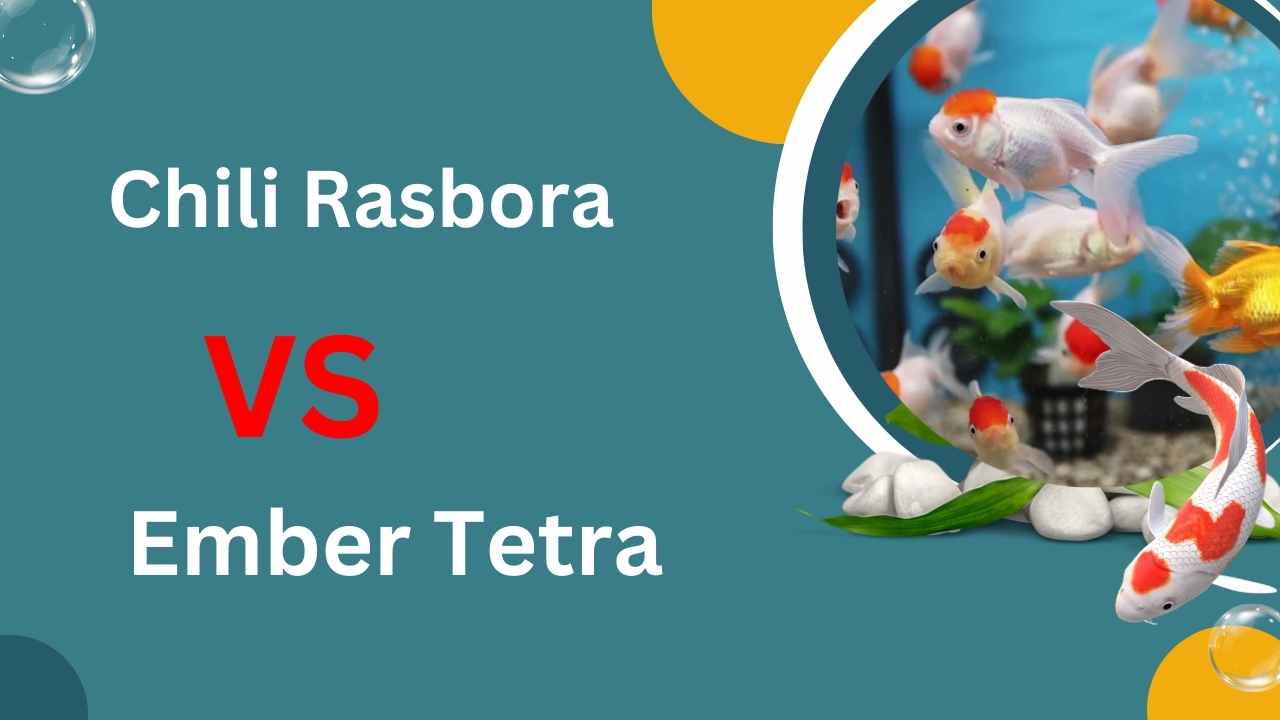Chili Rasbora and Ember Tetra are two species of freshwater fish that are popular among aquarium hobbyists due to their vibrant colors, small size, and peaceful nature. These species are native to South America and are known for their unique physical characteristics and behavior patterns. Chili Rasbora is a small, active fish with a red-orange body and black line through its tail, while Ember Tetra has a bright orange body and a distinctive black patch on its tail. These fish are easy to care for, but their ideal habitat and water requirements may vary slightly. When kept in the proper conditions, these species make for a vibrant and lively addition to any aquarium.
Physical Characteristics
Chili Rasbora
The Chili Rasbora (Boraras brigittae) is a small, freshwater fish that typically grows up to 0.7 inches in length. It has a distinctive red-orange body with a black line running through its tail. The fish has a sleek and slender body shape, with a slightly curved profile and a transparent dorsal fin. The fins are typically red or orange in color, and the eyes are large and slightly bulging. The black line running through its tail sets Chili Rasbora apart from other similar-looking fish species. The overall appearance of the Chili Rasbora is bright, vibrant, and eye-catching.

Chili Rasbora
Ember Tetra
The Ember Tetra (Hyphessobrycon Amandae) is a small, freshwater fish that typically grows up to 0.75 inches in length. It has a bright orange body with a distinctive black patch located on its tail. The fish has a slender and streamlined body shape, with a transparent dorsal fin and small, rounded fins. The eyes are large and slightly bulging, and the body has a slight metallic sheen. The black patch on the tail is a key identifier for Ember Tetra, making it easily distinguishable from other similar-looking species. The overall appearance of the Ember Tetra is vibrant, lively, and attractive.

Ember Tetra
Systematic position
The systematic position of Chili Rasbora (Boraras Brigittae) and Ember Tetra (Hyphessobrycon Amandae) is as follows:
Phylum: Chordata
Subphylum: Vertebrata
Class: Actinopterygii
Order: Characiformes
Family: Characidae
Genus: Boraras (Chili Rasbora)
Hyphessobrycon (Ember Tetra)
Species: Boraras brigittae (Chili Rasbora)
Hyphessobrycon amandae (Ember Tetra)
Habitat and Natural Behavior
The Chili Rasbora and Ember Tetra are native to South America and are typically found in slow-moving rivers, streams, and other bodies of water with plenty of vegetation. In their natural habitat, they are active and peaceful fish that spend most of their time swimming and feeding.
Chili Rasboras are social fish that prefer to live in schools and are known for their active swimming behavior. They are active swimmers and enjoy plenty of open swimming space in their aquarium. They are also attracted to live plants and other decorations, which provide them with plenty of hiding places and surfaces to forage for food.
Ember Tetras are also social fish that prefer to live in schools, but they are typically shyer than Chili Rasboras. They prefer a densely planted aquarium with plenty of hiding places and vegetation. Ember Tetras are not as active as Chili Rasboras and spend much of their time hiding and resting.
In terms of behavior, both species are peaceful and are well-suited to aquariums with other small and peaceful fish species. They are also compatible with most types of aquarium setups, as long as they are provided with the proper conditions and care.
Requirements for Keeping in Aquariums
Both Chili Rasbora and Ember Tetra are hardy and easy-to-care-for fish species, making them suitable for beginner and experienced aquarium hobbyists alike. To keep these fish healthy and happy you should maintain good water quality, and perform regular water changes. Proper care and attention will ensure that Chili Rasbora and Ember Tetra thrive in your aquarium and add a vibrant pop of color and life. Here are the basic requirements for keeping these fish in an aquarium:
- Tank Size: A minimum tank size of 10 gallons is recommended for a school of Chili Rasbora or Ember Tetra.
- Water Parameters: These fish prefer water that is slightly acidic to neutral (pH 6.0-7.0) and soft to moderate in hardness (5-20 dGH). The water temperature should be kept between 72°F and 82°F.
- Filtration: A basic aquarium filter should be sufficient to keep the water clean and healthy for these fish.
- Lighting: Both species prefer low to medium light levels, so a standard aquarium light should be sufficient.
- Substrate: A soft and fine substrate, such as sand or small gravel, is best for these fish.
- Plants and Decorations: Both Chili Rasbora and Ember Tetra prefer a planted aquarium with plenty of vegetation and hiding places. Live plants, such as Java Fern, are ideal for this purpose, as they also help to maintain water quality.
Feeding and Diet
Both Chili Rasbora and Ember Tetra are omnivores and have a varied diet in their natural habitat. In an aquarium setting, a varied diet is important for maintaining the health and vitality of these fish. You should avoid over-feeding because this can lead to water quality problems and negatively impact the health of these fish. Here is what to feed them:
- Flakes or Pellets: A high-quality fish food in the form of flakes or pellets is the staple of their diet. These should form the bulk of their diet and should be fed in small quantities two or three times a day.
- Live or Frozen Foods: Supplementing their diet with live or frozen foods, such as brine shrimp, daphnia, or bloodworms, will provide them with additional nutrients and variety. These can be fed once or twice a week.
- Vegetables: Vegetables, such as blanched spinach or lettuce, can also be included in their diet. This will provide them with essential vitamins and minerals.
Compatibility with Other Fish
Both Chili Rasbora and Ember Tetra are peaceful and social fish that are well-suited to community aquariums. They are compatible with other small and peaceful fish species, making them ideal additions to a variety of aquarium setups. Here are some recommended tank mates:
- Other Rasbora or Tetra species: Chili Rasbora and Ember Tetra are compatible with other small and peaceful fish from the same family, such as Neon Tetras or Cardinal Tetras.
- Other small fish: Other small, peaceful fish species, such as Corydoras catfish or Otocinclus catfish, are also good tank mates for Chili Rasbora and Ember Tetra.
- Shrimp: Both species are also compatible with peaceful shrimp species, such as Cherry Shrimp or Ghost Shrimp.
Maintenance and Care
Maintaining a healthy and thriving aquarium environment for Chili Rasbora and Ember Tetra requires regular care and attention. Here are some important steps to take to ensure their well-being:
- Water Changes: Regular water changes are important to maintain good water quality and prevent the buildup of harmful substances. A water change of 10-20% of the tank volume every 1-2 weeks is recommended.
- Filtration: Regular maintenance and cleaning of the aquarium filter is important to keep it functioning properly and to prevent the buildup of harmful substances.
- Lighting: It is important to provide a consistent light cycle, with a period of darkness each day. This will help to maintain a healthy and stable aquarium environment.
- Diet: A varied diet, including high-quality flakes or pellets, live or frozen foods, and vegetables, is important to maintain the health and vitality of Chili Rasbora and Ember Tetra.
- Compatibility: It is important to ensure that all of the fish in the aquarium are compatible and can live together peacefully. Keeping a balanced community of compatible fish species will help to reduce stress and promote a healthy aquarium environment.
Sexing
Sexing Chili Rasbora and Ember Tetra can be difficult or challenging, even for experienced aquarists as these species do not display many physical differences between males and females. In some species of fish, males may have more colorful fins or body markings, but this is not the case for Chili Rasbora and Ember Tetra. If you are unsure about the sex of your fish, it is best to consult with an experienced aquarium professional for assistance.
However, there are a few methods that can be used to determine the sex of these fish. One method is to observe the fish during breeding season, as males may display more aggressive or territorial behavior, or may develop breeding tubercles on their fins. Another method is to examine the shape and size of the fish’s vent, as females may have a rounder or larger vent than males.
It is also possible to determine the sex of Chili Rasbora and Ember Tetra through a process called “gonad extraction,” where a small sample of tissue is taken from the fish and examined under a microscope.
Breeding and Reproduction
Breeding Chili Rasbora and Ember Tetra in an aquarium environment can be a challenging but rewarding experience. With proper care and attention, you can successfully raise a new generation of these beautiful and fascinating fish. Here are some key steps for breeding these species:
- Conditioning: To encourage breeding, it is important to condition the fish with a varied diet and to provide a stable and healthy aquarium environment.
- Aquarium setup: A breeding tank should be set up with a soft substrate, such as fine sand or sponge, and should be well-planted with plenty of hiding places. The water in the breeding tank should have a slightly higher temperature and a lower pH than the main aquarium.
- Triggering Spawning: To trigger spawning, it may be necessary to make some small adjustments to the aquarium environment, such as increasing the temperature or adding a spawning mop.
- Egg Care: Once the eggs have been laid, it is important to carefully remove the breeding pair to prevent them from eating the eggs. The eggs will hatch in 2-3 days, and the fry will become free-swimming after another 2-3 days.
- Fry Care: The fry should be fed small amounts of live or frozen foods, such as baby brine shrimp or infusoria, to help them grow and develop.
Differences and Similarities between Chili Rasbora and Ember Tetra
Chili Rasbora and Ember Tetra are two species of small, colorful fish that are popular in the aquarium hobby. Here are some of the differences and similarities between these two species:
Differences:
- Physical appearance: Chili Rasbora has a longer, more slender body shape with a bright red coloration, while Ember Tetra has a more rounded body shape with an orange-red coloration.
- Origin: Chili Rasbora is native to Southeast Asia, while Ember Tetra is native to South America.
- Size: Chili Rasbora is generally larger than Ember Tetra, growing to an adult size of up to 0.7 inches in length.
Similarities:
- Peaceful nature: Both Chili Rasbora and Ember Tetra are peaceful and social fish that are well-suited to community aquariums.
- Compatibility with other fish: Both species are compatible with other small and peaceful fish species, making them ideal additions to a variety of aquarium setups.
- Lighting and water conditions: Both Chili Rasbora and Ember Tetra prefer a well-lit aquarium with a stable temperature and pH.
- Diet: Both species are omnivores and prefer a varied diet of high-quality flakes or pellets, live or frozen foods, and vegetables.
Which Species Is Better Choice for Aquarium?
Ultimately, the choice between Chili Rasbora and Ember Tetra will depend on personal preference and the specific requirements of the aquarium setup. Both species are hardy, colorful, and easy to care for, making them good choices for the beginner or experienced aquarist.
Disease and Treatment
Like all fish, Chili Rasbora and Ember Tetra can be susceptible to a range of diseases. To prevent disease from affecting Chili Rasbora and Ember Tetra, it is important to maintain a healthy and stable aquarium environment, to feed a balanced diet, and to quarantine new fish before introducing them to the main aquarium. If you suspect that your fish are sick, it is important to consult with an experienced aquarium professional for advice on treatment and care.
Here are some of the most common diseases that can affect these species, along with steps that can be taken to prevent and treat them:
- Ich: Ich, or white spot disease, is a common parasite that can cause small white spots to appear on the skin and fins of infected fish. To treat Ich, it is important to raise the temperature of the aquarium and to treat with a suitable aquarium medication.
- Fin Rot: Fin rot is a bacterial infection that causes the fins to become frayed and ragged. To treat fin rot, it is important to maintain good water quality and to treat with a suitable aquarium medication.
- Swim Bladder Disease: Swim bladder disease is a condition that can cause fish to float upside down or struggle to swim properly. To treat swim bladder disease, it is important to feed the fish a balanced diet and to avoid overfeeding.
- Fungal Infections: Fungal infections can cause white or gray growths to appear on the skin and fins of infected fish. To treat fungal infections, it is important to maintain good water quality and to treat with a suitable aquarium medication.
- Parasitic Infestations: Parasites such as lice and anchor worms can infest the skin and fins of fish. To treat parasitic infestations, it is important to treat with a suitable aquarium medication and to maintain good water quality.
Frequently Asked Questions
Here are some frequently asked questions about Chili Rasbora and Ember Tetra:
Question-1: What is the lifespan of Chili Rasbora and Ember Tetra?
Answer: The average lifespan of Chili Rasbora and Ember Tetra is 3 to 5 years with proper care.
Question-2: Do Chili Rasbora and Ember Tetra need a heater in their aquarium?
Answer: It is recommended to use a heater in the aquarium to maintain stable water temperature, especially for Chili Rasbora and Ember Tetra, which are tropical fish species that prefer a warm water environment.
Question-3: Are Chili Rasbora and Ember Tetra suitable for a community aquarium?
Answer: Yes, both Chili Rasbora and Ember Tetra are peaceful and social fish that are well-suited to community aquariums.
Question-4: Can Chili Rasbora and Ember Tetra be bred in captivity?
Answer: Yes, Chili Rasbora and Ember Tetra can be bred in captivity, although it may require a well-maintained and specialized breeding setup. If you are interested in breeding these species, it is recommended to consult with an experienced aquarium professional for guidance and advice.
Suitable Tankmates
Chili Rasbora and Ember Tetra are peaceful and social fish that are well-suited to community aquariums. They are compatible with a wide variety of other peaceful fish species, such as:
- Guppies
- Neon tetras
- Shrimp
- Corydoras catfish
- Mollies
- Swordtails
- Platies
- Discus fish
Quick stats
Here is a quick summary of the main stats for Chili Rasbora and Ember Tetra:
Chili Rasbora:
• Scientific name: Boraras brigittae
• Adult size: 0.7 inches
• Life span: 5-6 years
• Water temperature: 72-78°F (22-26°C)
• Water pH: 6.0-7.5
• Water hardness: 5-15 dH
• Compatibility: Peaceful and social, suitable for community aquariums
• Diet: Omnivorous, feeds on small live and frozen foods such as brine shrimp, daphnia, and bloodworms
Ember Tetra:
• Scientific name: Hyphessobrycon amandae
• Adult size: 0.5 to 0.7 inches
• Life span: 3-5 years
• Water temperature: 72-78°F (22-26°C)
• Water pH: 6.0-7.5
• Water hardness: 5-15 dH
• Compatibility: Peaceful and social, suitable for community aquariums
• Diet: Omnivorous, feeds on small live and frozen foods such as brine shrimp, daphnia, and bloodworms
Conclusion
In conclusion, Chili Rasbora and Ember Tetra are both popular and attractive species of freshwater fish that are well-suited to life in community aquariums. Both species are peaceful, hardy, and easy to care for, making them an excellent choice for hobbyists of all experience levels. Chili Rasbora and Ember Tetra can thrive and bring beauty and activity to any aquarium for many years to come.

